The use of acoustic devices to warn marine mammals of tidal-stream energy devices
This report explores the potential need for acoustic deterrent devices at high energy sites to warn marine mammals to the presence of tidal devices.
Is there a problem to fix?
Though most full-scale turbines have not yet been constructed it is likely that they will generate sufficient noise to be audible to marine mammals (Carter 2007; 2013). The range over which these devices will be audible will be subject to the efficiency of sound propagation in tidal sites and, crucially, the ambient noise already present in these locations. If ambient noise is high then device audibility would be reduced to ranges such that additional acoustic cues could prove necessary (i.e. ADDs, AHDs etc.). Of the variables stated above (propagation, device and ambient noise), ambient noise in tidal-stream sites is poorly known to the extent that there is too little information from other locations to generalise with any degree of certainty. Therefore, to generate real information on the acoustic properties of tidal sites we investigated the ambient soundscapes of three tidal-stream sites on the west-coast of Scotland. Two were sites that are of immediate interest to tidal-stream developers (the Sound of Islay and Kyle Rhea) and the third has received a little tidal-stream developer interest but represents a lesser resource and is subject to highly turbulent flows (Falls of Lora).
To record ambient sound in tidal sites we utilised the SAMS-European Marine Energy Centre's ( EMEC) "Drifting Ears" method which uses drifting acoustic recorders to document ambient sound (Wilson et al., In press). The autonomous drifters each consist of a subsurface hydrophone suspended within a drogue which itself is attached to a surface float and dan-buoy fitted with batteries, preamplifiers, a sound recorder and GPS unit. The units are self-contained and waterproof such that they can be released into the water upstream of a site and allowed to drift through it, recording ambient sound as they go. The use of drifters allows recording in strong tidal streams without the artefacts associated with flow noise past the hydrophone (which troubles fixed recorders) and also the unwanted noises associated with hydrophones deployed from a boat.
For this study, four drifters were deployed in a line-abreast formation using a 6m RIB upstream of the site of interest then retrieved after they had drifted over the site, forty to sixty minutes later. During deployments the chase boat was kept at least 500m from the drifters with the engines silenced. Ambient underwater sound was recorded from 5 m below the surface and sampled at 96 kHz (16 bit). The hydrophone and recording equipment in each drifter was calibrated against a B&K 8104 reference hydrophone itself calibrated at the Aberdeen University Oceanlab test facility and then at the National Physical Laboratory, London.
Site 1: The Sound of Islay (55° 50'N 06° 06'W)
The Sound of Islay lies between the Islands of Islay and Jura and is subject to strong tidal-flows in excess of 3 m.s -1 at springs. At its narrowest, the sound is around 700 m wide, is 20 km long with the deepest point exceeds 60 m deep. On account of the glaciated bottom topography and straight sides, the flow through the sound is relatively laminar. The sound is regularly crossed by a ferry transiting the narrowest part (Port Askaig to Feolin) about half way along its length. Scottish Power Renewables have consent for a ten 1 MW turbine array immediately to the south of Port Askaig.
We collected ambient acoustic data in the site over five days between neap and spring tides in September 2009. Deployments were carried out on both ebb (south-going) and flood (north-going) tides in daylight. A car ferry also regularly traverses the narrows between Port Askaig and Feolin during daylight hours. Because this and other more sporadic vessels (ferries to the mainland, coasters, fishing boats etc.) produce considerable noise that would swamp the longer-term but lesser known ambient soundscape, we avoided times when these vessels were traversing the narrows. Weather during the study was generally favourable with sun and cloud and only short periods of light rain. Beaufort sea-states ranged from 0 to 5 but were predominantly 2 or less. Sampling was carried out along the whole length of the sound from the mouth in the north to the Black Rocks in the South (Figure 3). We sampled six ebb tides with four independent drifters generating 24 acoustic tracks and seven flood times generating 28 tracks. Sampling was carried over a period from late-neap into full spring tides. Because the drifters were passive we could not record in predetermined locations. Instead they were deployed across the current so that as they drifted they would generate a swath of recordings along the length of the sound.
In subsequent analyses we divided the Sound of Islay into a series of lines of latitude 150m apart and then used the drifters' on-board GPS logs to calculate at which point in the acoustic recordings each gateway was passed. A sixty second sound segment was then extracted from the recordings to characterise the soundscape at each line of latitude and the particular line of longitude from which the recording was made. The sound-sample duration of sixty seconds was chosen (from previous trials at EMEC) as an optimum compromise between the instantaneous variability in ambient noise and characterising a discrete location during a drift. In total, 596 of these sixty second samples were extracted and are shown with the dots in Figure 3.
Broadband Sound Pressure Levels ( SPL) for all of the recordings ranged from 114.5 to 130.9 dB re 1μPa. Analysis of SPL against local flow speed (derived from each drifter's on-board GPS) suggested that there was a weak relationship between sound intensity and flow speed. In general, as the flow speed increased, so the ambient noise increased. When stratified to greater or less than 2 m.s -1 underwater sound levels were found to be significantly different ( ANOVA General Linear Model using fixed factors of flow rate and direction, P<0.001, Figure 4.).
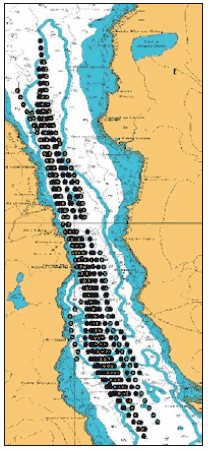
Figure 3. Sound sample locations in the Sound of Islay derived from 52 drifts. The dots represent the central location of each 60 second sound segment used to characterise the ambient soundscape of the site.
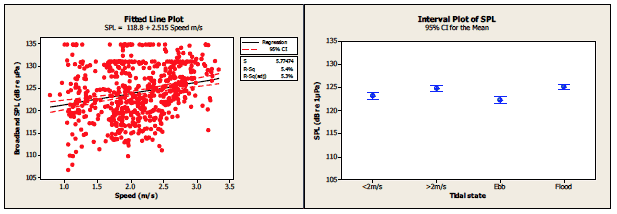
Figure 4. Left panel: Comparison of tidal flow speed against underwater noise which demonstrated a tendency for sound to increase with water speed. Right panel: Significant differences between greater or less than 2 m.s -1 and also between ebb and flood tides.
When mapped it was clear that as well as rate of water flow influencing sound levels, location also made an important difference to ambient underwater noise. There were distinct patches of high and low sound intensity (Figure 5). In particular, the waters at the narrowest part of the sound (off Port Askaig) experienced the highest levels of underwater ambient sound while areas where the strait opened out (particularly to the south east - off Black Rocks) were subject to less intense underwater sound levels. The reasons for this "sound-topography" are unknown but a variety of factors may be at play, particularly any flow-generated sediment transport over rock, patches of "snapping shrimps" and turbulence in the water itself and associated surface disturbances (tide generated waves, ripples and so on). Though we attempted to survey when the ferry was not crossing the sound, at times its engine was left in idle when the vessel was tied up and this may have further contributed to the intensified background around Port Askaig.
As described earlier, we attempted to avoid the sound produced by operating ferries, transiting ships and other vessels from contaminating the sampling of non-anthropogenic ambient noise. Nevertheless these vessels contribute substantially to the ambient noise budget of these and other coastal sites. However, because their output is sporadic, somewhat predictable and present only a small fraction of the total time, we excluded them from our consideration of ambient sound here. Being better quantified in the literature than natural ambient sound and a point source of sound, it is however possible to retrospectively add their signature to such sites.
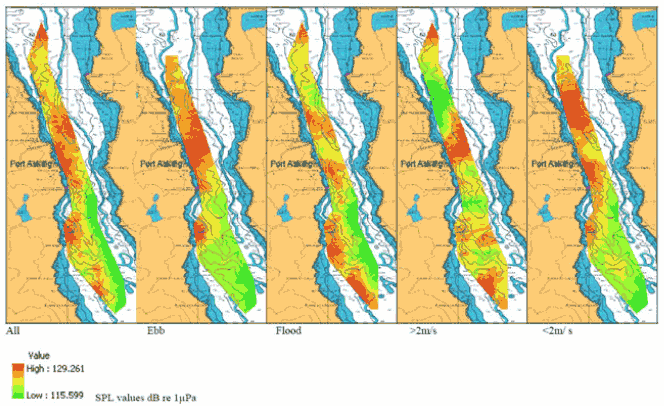
Figure 5. Underwater sound maps of the Sound of Islay summed (left) and divided by tidal direction (middle) and rate of flow (right). The lowest observed intensities are represented by shades of green and the highest in shades of red.
Site 2: Kyle Rhea (57° 14'N 05° 39'W)
Like the Sound of Islay, Kyle Rhea was chosen in this study as it is an inshore site experiencing substantial tidal-streams and of immediate interest to tidal energy developers. The site is a narrow strait between the Isle of Skye and the Scottish mainland. The narrows are approximately 3.5 km long and slightly tapered from the north (700 m wide) to the south (350 m at the narrowest). The waterway is bounded by Loch Alsh to the north and the Sound of Sleat to the south. Tidal streams flow northwards on the flood and southwards on the ebb and reach rates in excess of 2.3 m.s -1 at springs. Again because of the glaciated and smoothed out rock shape of the strait, the flow through the site is relatively laminar. The Kyle Rhea is crossed by a small ferry at its narrowest point in the south. Several companies have expressed interest using this site to develop tidal-stream energy, notably Marine Current Turbines who are exploring the potential to generate around 8 MW from the site ( MCT press release, April 2011).
We collected acoustic data from the site in the early summer of 2011 (17 th May). Several attempts at data collection prior to and after this date were abandoned due to unsuitable weather conditions, primarily heavy rain and strong winds. The sampling period fell during spring tides and the inclement weather was dry with some heavy rain and light to moderate winds from the southwest (3.5 - 16 m.s -1), which in combination with the tide created agitated sea conditions particularly in the northern Sound of Sleat and southern Kyle Rhea. It was calmer elsewhere. Being summer, the small car ferry ran almost constantly during the surveys and being broadband its acoustic signature was impossible to extract from recordings.
For the analyses, the drifter tracks were separated into latitude bands 150 m apart and a sixty second sound segment extracted from the acoustic file to represent that site. This generated 228 sound samples (Figure 6). As with the Sound of Islay work, the individual drifters were calibrated during the study using a B&K hydrophone, itself calibrated by the National Physical Laboratory (London)
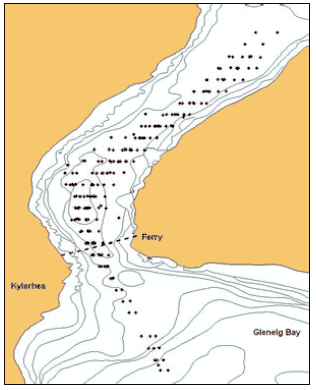
Figure 6. Kyle Rhea and northern Sound of Sleat and 228 acoustic sampling stations (separated in latitude by 150 m). The ferry track is also shown (dotted line) where the strait is narrowest (300 m).
Broadband Sound Pressure Levels ( SPL) for all of the recordings ranged from 116 to 137 dB re 1μPa. Overall, therefore, the lower sound levels experienced were very similar to the Sound of Islay (116 cf 115 dB) but the upper extreme was considerably higher (137 cf 129 dB). Analysis of SPL against local flow speed again found a weak positive relationship between sound intensity and flow speed. When stratified to flow rates greater or less than 2 m.s -1 and also compared to ebb and flood tides underwater sound levels were found to be significantly different ( ANOVA General Linear Model using fixed factors of flow rate and direction, P<0.001, Figure 7.). In contrast to the Sound of Islay, the ebb tide recordings were louder than the flood, most probably because of the south westerly wind conflicting with the south-going flow of the ebb tide and associated tidally derived surface waves particularly in the Sound of Sleat (Figure 8). In addition, the inclusion of sound files recorded during ferry movements would have contributed to the increased sound levels. When mapped, the higher intensity sounds in the southern portion of the area are clearly apparent. This is particularly clear in the tide against wind (ebb: south-going ebb, wind: north-east going) and converse flood tide with wind scenarios (Figure 8). Though wind/waves and the ferry may explain some of the spatial structuring of the sound field it does not explain it all. Other factors such as sediment bed-load and snapping shrimps are likely to impinge on the sound field. The observation of discrete sound patches in the upper Kyle Rhea (Figure 8, extreme right panel) suggests that such other factors are also present.
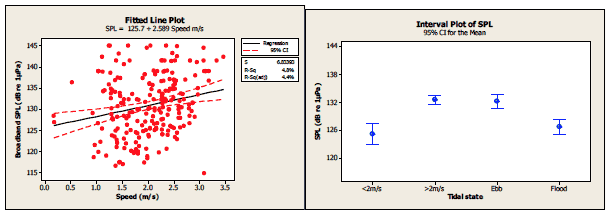
Figure 7. Left panel: Comparison of tidal flow speed against underwater noise in the Kyle Rhea which demonstrated a tendency for sound to increase with water speed. Right panel: Significant differences in sound intensity between greater or less than 2 m.s -1 and also between ebb (more) and flood (less) tides. Together tidal speed and direction explained 18% of the variation.
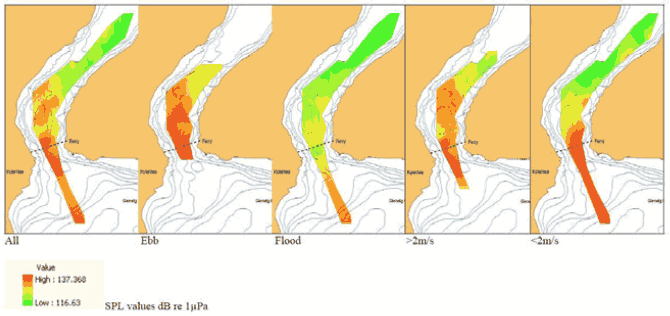
Figure 8. Underwater sound maps of the Kyle Rhea and upper Sound of Sleat. Left: summed Middle: divided by tidal direction, Right: rate of flow. The lowest observed intensities are represented by shades of green and the highest in shades of red.
Site 3: Falls of Lora (56° 27'N 05° 23'W)
In contrast to the other two sites studied, the Falls of Lora is at the mouth of a sea loch (Loch Etive) where the tide is forced to move over a shallow, narrow sill. The irregular bottom topography and constriction generates a turbulent flow with standing waves and extensive vertical mixing. Though there used to be a ferry crossing at this site, there is now a single span bridge. Flow rates range up to 4 m.s -1 on springs and the falls at their narrowest are around 170 m across. The site has been discussed as a potential site of tidal-energy extraction but only in terms of a site for prototype devices or small scale local deployment (Argyll and Bute Council 2011).
We collected acoustic data from the Falls of Lora in mid-June 2011 on an ebb tide (i.e. tide flowing out of the loch). There was no rain during the survey and only light winds (<1.5 m.s -1). We could not set sample points in the usual manner as the extreme turbulence introduced periods of self-noise among the recording equipment (hydrophone-bumping into the drogue). Instead, any sound segments with this self-noise were excluded and only clean 60 second segments used.
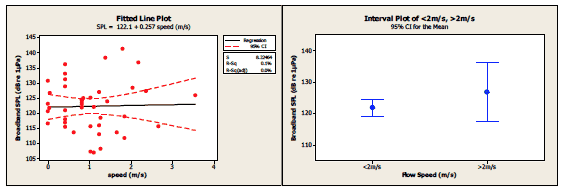
Figure 9. Left panel: Comparison of tidal flow speed against underwater noise in the Falls of Lora which demonstrated the large variation in sound levels at speeds greater than 0.5 m.s -1 and a very weak tendency for sound to increase with water speed. Right panel: Differences in sound intensity between flow rates less and greater than 2 m.s -1.
The sound levels encountered in the Falls of Lora showed the greatest range of any of the three sites, fluctuating from 106 to 141 dB and presenting both the quietest and loudest levels encountered in this study (Figure 9). Mapping these levels demonstrated that the most turbulent flow at the narrows and immediately downstream generated the highest sound levels and that lower intensities were encountered in the less confused waters at greater distance from the narrows (Figure 10). The highest flow rates were experienced to the south side of the channel and in the immediate vicinity of the areas of the most intense ambient sound.
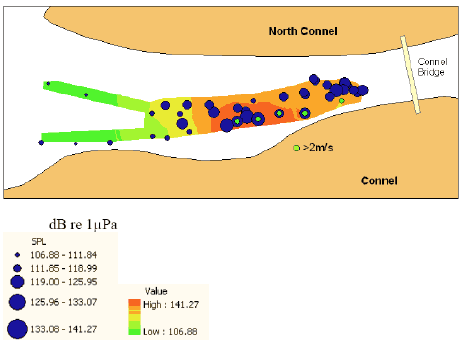
Figure 10. Underwater sound maps of the western Falls of Lora. The lowest observed intensities are represented by shades of green (and small circles) and the highest in shades of red (larger circles). The recordings made in water moving faster than 2 m.s -1 are shown with green dots.
Comparing sites
When the three sites are compared (Table 1) all experienced broadly similar ranges of flow speeds, ranging from near still patches of water (usually near the shoreline) to strong flows with upper speeds from 3.3 to 3.5 m.s -1 (~6 to 7 knots). However, while all three experienced similar ranges, both the Sound of Islay and Kyle Rhea experienced average speeds that were alike (around 2 m.s -1), while the Falls of Lora experienced around half these speeds at its average. This is likely because of the substantial discontinuities in the flow of the Falls of Lora site with large areas of confused water and wide back-eddies to either side of the main flow. Measured ambient sound levels were equally variable, with the Sound of Islay and Kyle Rhea showing broadly similar sound levels and the Falls of Lora showing the greatest variability both above and below the levels experienced elsewhere. The elevated levels of the Kyle Rhea compared with the Islay site are likely a result of the poor weather during surveying and the near-continuous operation of the small ferry.
Table 1. A comparison of the three sites monitored.
| Sound of Islay | Kyle Rhea | Falls of Lora | |
|---|---|---|---|
| SPL range (dB re 1 μPa) | 114-131 | 116-137 | 106-141 |
| Depth (m) | 0-60 | 0-36 | 0-30 |
| Flow speed: range (m.s -1) |
0.79-3.34 | 0.18-3.47 | 0-3.56 |
| Flow speed: average (m.s -1) | 2.10 | 2.02 | 1.02 |
| Survey time of year | September | May | June |
| Weather conditions | Good | Poor | Good |
In terms of what we can learn from measuring sound in these three sites, it is informative for the wider ambitions of this study to discover that the ambient underwater sound levels experienced in both sites of immediate commercial interest were broadly similar and ranged from 114-137 dB re 1 μPa.
Since the Kyle Rhea recordings were subject to site-specific boat traffic and a time limited recording window, for this generic study it is most appropriate to use the Sound of Islay as a model site for considering how far the acoustic output from warning devices may propagate under natural conditions. From there we can consider how much spatial warning additional sounds may provide animals manoeuvring in the vicinity of turbines.
Of course, most tidal sites are also subject to vessel traffic (whether crossing ferries, transiting or fishing). Furthermore, once turbines are installed, increased vessel movements for maintenance are likely. These anthropogenic sound sources will sporadically dominate the soundscapes of these sites and should also be considered alongside the more continuous ambient soundscapes in more detailed site-specific modelling.
Contact
There is a problem
Thanks for your feedback